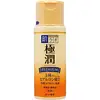Hada Labo Ultimate Moisturizing Light Lotion Versus Hada Labo Gokujyun Premium Hyaluronic Acid Emulsion
What's inside
What's inside
 Key Ingredients
Key Ingredients

 Benefits
Benefits

 Concerns
Concerns

 Ingredients Side-by-side
Ingredients Side-by-side

Tranexamic Acid
AstringentSodium Hyaluronate
HumectantHydrolyzed Hyaluronic Acid
Humectant3-O-Ethyl Ascorbic Acid
Skin ConditioningTocopherol
AntioxidantGlycerin
HumectantDiglycerin
HumectantDipropylene Glycol
HumectantSorbitol
HumectantPentylene Glycol
Skin ConditioningPPG-17 Butyl Ether
Skin ConditioningPolyglyceryl-10 Eicosanedioate/Tetradecanedioate
Skin ConditioningButylene Glycol
HumectantDiethoxyethyl Succinate
SolventPolyglyceryl-2 Hydroxypropyl Ethylhexyl Ether
CleansingSqualane
EmollientC4-18 Alkyl Methacrylate/Methacryloyloxyethyl Phosphorylcholine Copolymer
HumectantPetrolatum
EmollientCetearyl Alcohol
EmollientBehenyl Alcohol
EmollientXanthan Gum
EmulsifyingAcrylic Acid/C12-22 Alkyl Acrylate Copolymer
StabilisingPolyvinylalcohol Crosspolymer
PEG-20 Sorbitan Isostearate
EmulsifyingGlyceryl Stearate
EmollientEDTA
Melaleuca Alternifolia Leaf Oil
AntioxidantSodium Metabisulfite
AntioxidantPhenoxyethanol
PreservativeIodopropynyl Butylcarbamate
PreservativeSodium Paraben
PreservativeTranexamic Acid, Sodium Hyaluronate, Hydrolyzed Hyaluronic Acid, 3-O-Ethyl Ascorbic Acid, Tocopherol, Glycerin, Diglycerin, Dipropylene Glycol, Sorbitol, Pentylene Glycol, PPG-17 Butyl Ether, Polyglyceryl-10 Eicosanedioate/Tetradecanedioate, Butylene Glycol, Diethoxyethyl Succinate, Polyglyceryl-2 Hydroxypropyl Ethylhexyl Ether, Squalane, C4-18 Alkyl Methacrylate/Methacryloyloxyethyl Phosphorylcholine Copolymer, Petrolatum, Cetearyl Alcohol, Behenyl Alcohol, Xanthan Gum, Acrylic Acid/C12-22 Alkyl Acrylate Copolymer, Polyvinylalcohol Crosspolymer, PEG-20 Sorbitan Isostearate, Glyceryl Stearate, EDTA, Melaleuca Alternifolia Leaf Oil, Sodium Metabisulfite, Phenoxyethanol, Iodopropynyl Butylcarbamate, Sodium Paraben
Ingredients Explained
These ingredients are found in both products.
Ingredients higher up in an ingredient list are typically present in a larger amount.
Dipropylene Glycol is a synthetically created humectant, stabilizer, and solvent.
This ingredient helps:
Dipropylene glycol is technically an alcohol, but it belongs to the glycol family (often considered part of the ‘good’ alcohols). This means it is hydrating and gentle on skin unlike drying solvent alcohols like denatured alcohol.
As a masking agent, Dipropylene Glycol can be used to cover the smell of other ingredients. However, it does not have a scent.
Studies show Dipropylene Glycol is considered safe to use in skincare.
Learn more about Dipropylene GlycolGlycerin is already naturally found in your skin. It helps moisturize and protect your skin.
A study from 2016 found glycerin to be more effective as a humectant than AHAs and hyaluronic acid.
As a humectant, it helps the skin stay hydrated by pulling moisture to your skin. The low molecular weight of glycerin allows it to pull moisture into the deeper layers of your skin.
Hydrated skin improves your skin barrier; Your skin barrier helps protect against irritants and bacteria.
Glycerin has also been found to have antimicrobial and antiviral properties. Due to these properties, glycerin is often used in wound and burn treatments.
In cosmetics, glycerin is usually derived from plants such as soybean or palm. However, it can also be sourced from animals, such as tallow or animal fat.
This ingredient is organic, colorless, odorless, and non-toxic.
Glycerin is the name for this ingredient in American English. British English uses Glycerol/Glycerine.
Learn more about GlycerinHydrolyzed Hyaluronic Acid is a form of hyaluronic acid. It is created by the hydrolysis of hyaluronic acid with a high molecular weight. Once created, Hydrolyzed Hyaluronic Acid has a low molecular weight.
Low molecular weight HA has been shown to hydrate and increase elasticity of the skin. Increasing elasticity is also associated with reduction of wrinkle depth.
One study found topical low molecular weight hyaluronic acid may be considered for the treatment of rosacea in the adult population. However, we always recommend speaking with a professional about your skin concerns.
Hyaluronic acids are a humectant. This means they draw moisture from the air. Hyaluronic acids help moisturize, soothe, and protect the skin.
Read more about other common forms of hyaluronic acid:
Learn more about Hydrolyzed Hyaluronic AcidSodium Hyaluronate is hyaluronic acid's salt form. It is commonly derived from the sodium salt of hyaluronic acid.
Like hyaluronic acid, it is great at holding water and acts as a humectant. This makes it a great skin hydrating ingredient.
Sodium Hyaluronate is naturally occurring in our bodies and is mostly found in eye fluid and joints.
These are some other common types of Hyaluronic Acid:
Learn more about Sodium Hyaluronate